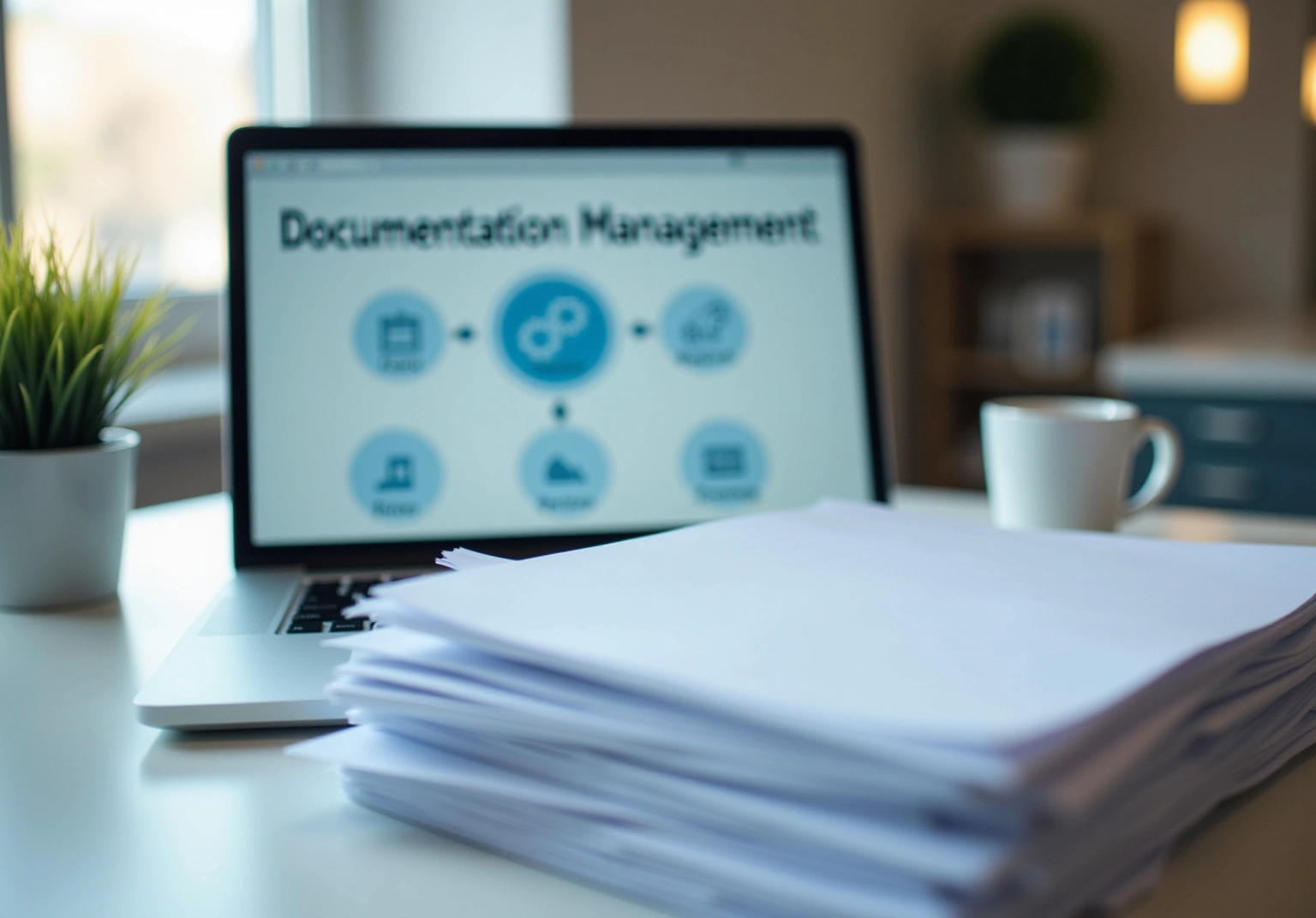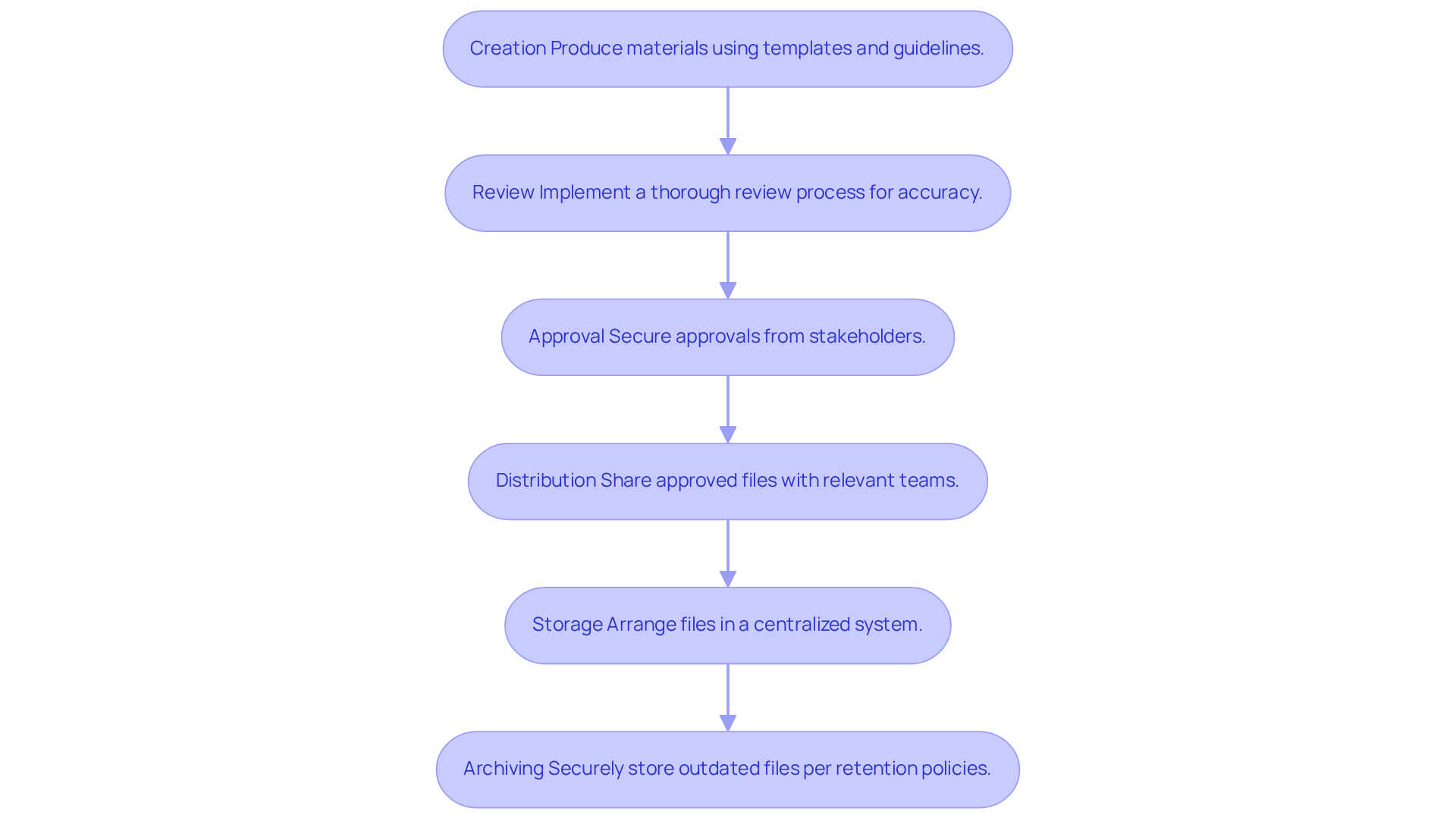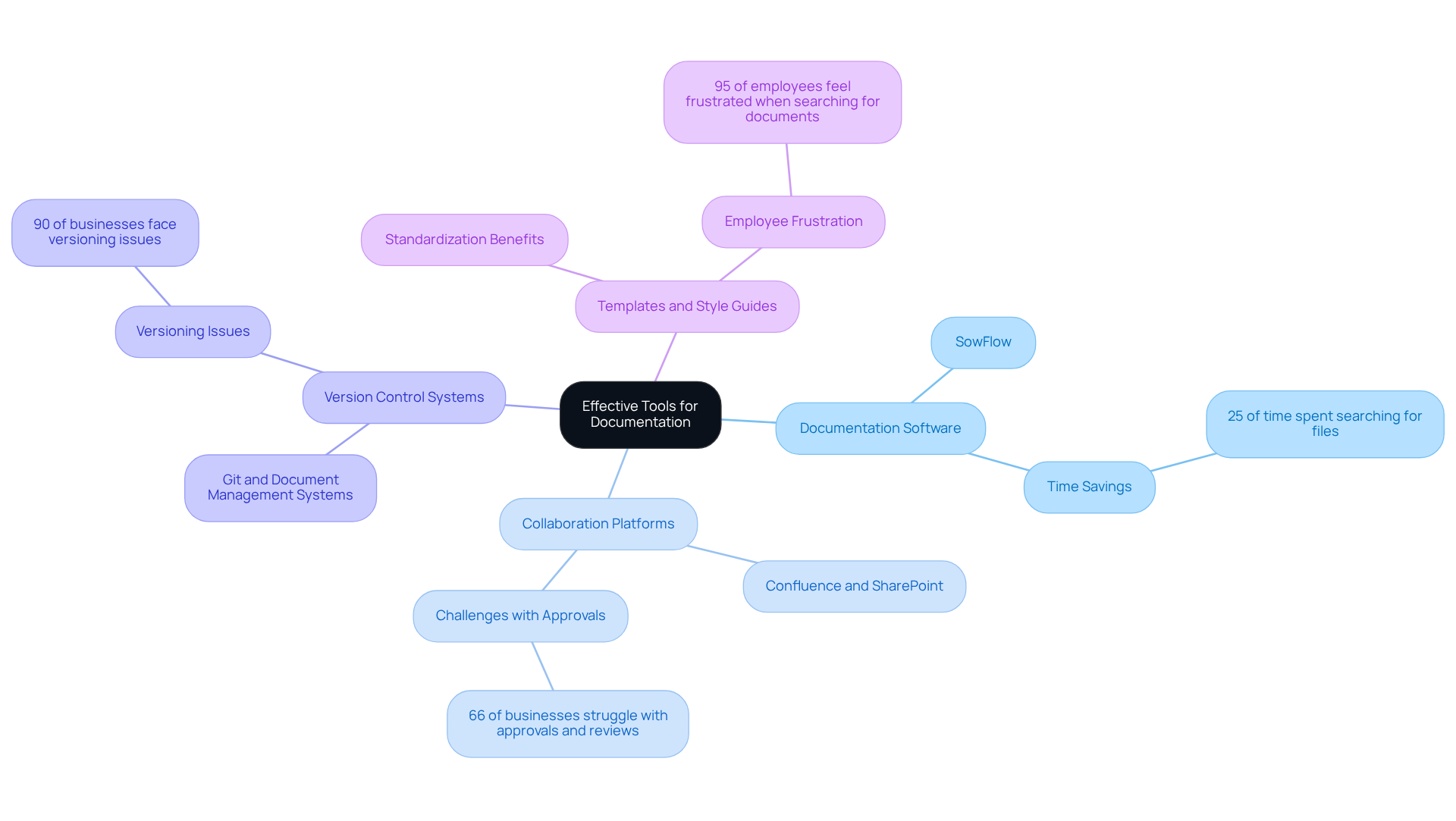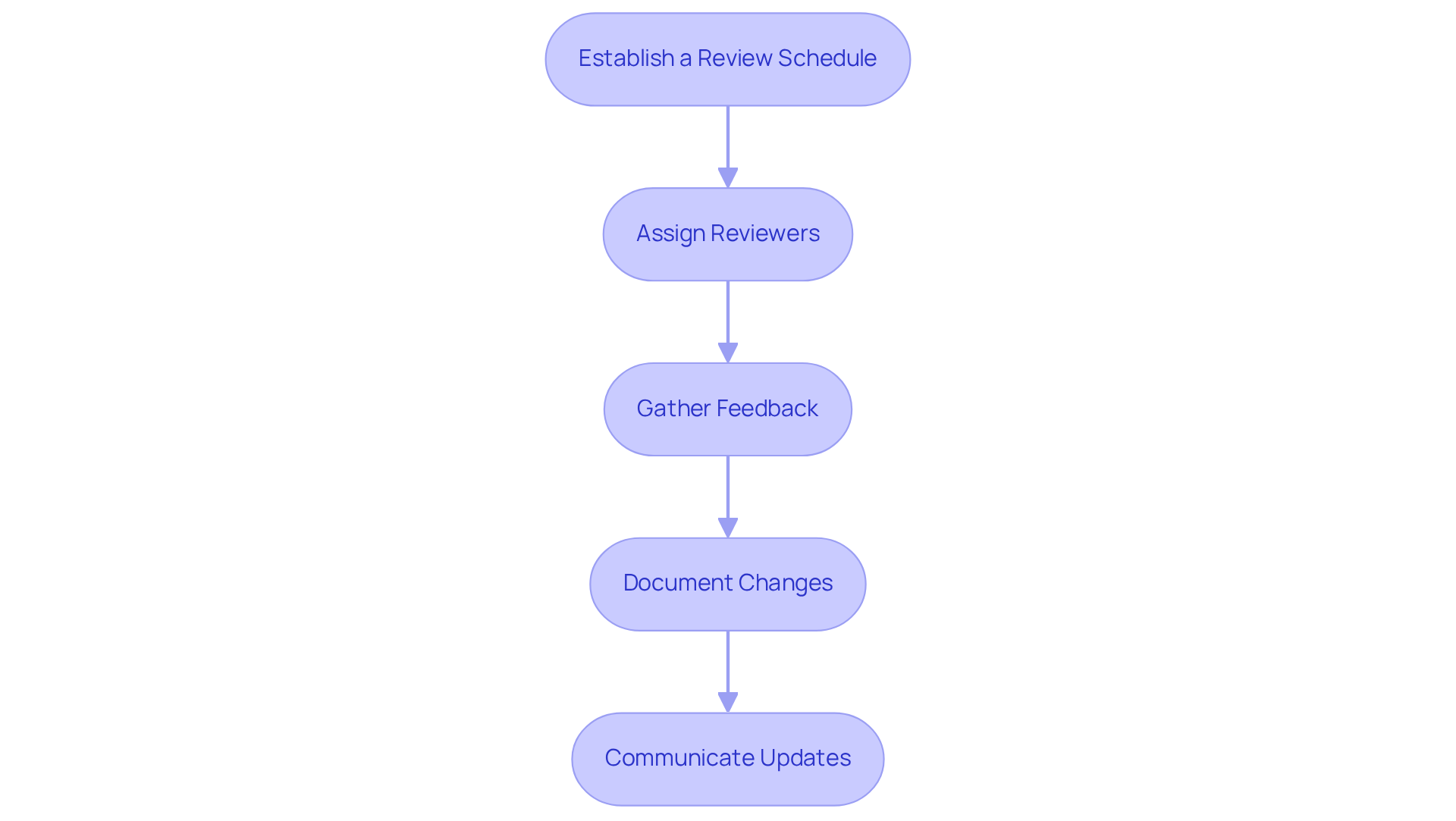
Process Improvement through Documentation
|
October 16, 2025
|
4 Steps Process for Effective Documentation Management
Overview
You might be wondering how to tackle documentation management effectively. Well, there's a neat four-step process that can really help:
- Creation
- Review
- Approval
- Distribution
By following this structured approach, you can boost your operational efficiency. It reduces errors, speeds up approvals through automation, and makes accessing documents a breeze. Ultimately, this addresses those frustrating productivity losses that often come from poor documentation practices. So, why not dive into these steps and see how they can transform your workflow?
Key Highlights:
- The documentation management process includes six key steps: Creation, Review, Approval, Distribution, Storage, and Archiving.
- Creation involves producing materials using templates to ensure consistency.
- A thorough Review process reduces errors, potentially preventing a 21.3% productivity loss.
- Securing Approval from stakeholders ensures alignment and can speed up the process by 30% with automation.
- Distribution of approved documents improves access, reducing time spent searching for materials, which averages two hours daily.
- Centralised Storage can decrease lost items by 90%, enhancing file accessibility.
- Archiving outdated files while adhering to retention policies preserves organisational integrity.
- Setting clear objectives involves identifying stakeholders, defining SMART goals, aligning with business goals, and communicating these objectives.
- Using documentation software can save a significant amount of time, as employees often spend 25% of their workweek searching for files.
- Collaboration platforms enhance teamwork, addressing the 66% of businesses that struggle with approvals and reviews.
- Version control systems are essential to prevent issues, as 90% of businesses face versioning challenges.
- Regular review schedules, feedback gathering, and effective communication of updates are crucial for maintaining high-quality documentation.
Introduction
In a world where information overload can really put a damper on productivity, effective documentation management stands out as a vital lifeline for organizations aiming for efficiency. You might be wondering how this works, right? Well, this article dives into a structured four-step process that not only boosts operational effectiveness but also helps cut down on those pesky costly errors and time-wasting moments. But here’s the kicker: as many companies struggle with common record-keeping pitfalls, the big question is—how can organizations make sure their documentation practices are not just efficient but also in sync with their broader business goals?
Define the Steps Process in Documentation Management
You might be wondering how the documentation management process works and why it’s so important. Well, it addresses several key phases in the steps process that really help keep things running smoothly and accurately. Let’s break it down:
- Creation: This is where you produce materials using established templates and guidelines. It’s a great way to maintain consistency and quality in your documents.
- Review: Now, this phase is all about implementing a thorough review process. It helps verify accuracy and completeness, which can really reduce the risk of errors that might lead to productivity losses. Did you know that document-related challenges can result in a 21.3% productivity loss?
- Approval: Next up is securing those all-important approvals from stakeholders. This ensures that everyone is aligned and informed. And here’s a fun fact: automated workflows can speed up the approval process by 30%!
- Distribution: Once approved, it’s time to share files with the relevant teams and individuals. This makes accessing information seamless and cuts down on the time spent searching for materials—something that costs employees an average of two hours a day.
- Storage: You’ll want to arrange files in a centralized system for easy retrieval. This can lead to a whopping 90% decrease in lost or misplaced items, making file accessibility a breeze.
- Archiving: Finally, it’s crucial to securely store outdated files while sticking to retention policies. This helps preserve your organization’s integrity. Interestingly, 90% of companies have minimal or no records management processes, which highlights the need for a solid record-keeping framework.
By adhering to this steps process, you can build a robust record-keeping system that not only boosts operational efficiency but also significantly reduces mistakes, creating a more organized and scalable business environment. However, keep an eye out for common pitfalls in record management, like insufficient training and not updating files regularly, as these can really undermine your efforts.

Set Clear Objectives for Documentation Practices
To establish effective record-keeping practices, you might be wondering where to start. Well, organizations need to set clear objectives, and here’s how you can do it:
- Identify Key Stakeholders: Engage with the teams that will actually use the records. What are their specific needs and challenges? Understanding these can make all the difference.
- Define SMART Objectives: Think about creating specific, measurable goals. For instance, how about reducing paperwork time by 30% or boosting user satisfaction ratings by 20%? These goals should be achievable and relevant to drive meaningful change. Did you know that a regular-sized company can save up to 80% of the time spent on manual file sharing just by using Document Management Systems?
- Align with Business Goals: Make sure your objectives align with the broader aims of your organization, like improving operational effectiveness or enhancing customer satisfaction. This alignment creates a cohesive strategy that supports overall business success.
- Communicate Objectives: Share these objectives with all relevant teams. This step is crucial for cultivating a sense of ownership and accountability. Clear communication ensures everyone knows their role in achieving these goals.
By setting clear goals, organizations can establish a steps process to develop a targeted strategy for record-keeping that significantly boosts operational effectiveness and reduces chaos in workflows. Effective record-keeping methods can lead to a 21.3% improvement in productivity, which really highlights the importance of strategic goal-setting in this area. Plus, let’s not forget that inefficient paperwork processes can cause a 21.3% loss in efficiency for companies, underscoring the critical need for effective record-keeping strategies. And just think about it—Americans spend an average of two hours every day searching for files! That really emphasizes how important clear record-keeping goals are in minimizing time lost on retrieving materials.

Utilize Effective Tools for Documentation Creation and Management
You might be wondering how to make documentation creation and management a breeze. Well, let’s dive into some essential tools that can help!
- Documentation Software: Tools like SowFlow allow you to whip up and manage documentation right from your browser. This can save you a ton of time—after all, did you know that 25% of a full 40-hour work week is spent just searching for files? That’s a big chunk of time that could be better spent!
- Collaboration Platforms: Ever tried using platforms like Confluence or SharePoint? They really boost team collaboration and make sharing files super easy. This is especially important when you consider that 66% of businesses struggle with approvals and reviews. As David Kostya points out, '66% of businesses admitted to facing difficulties especially with approvals and reviews of paperwork.'
- Version Control Systems: Now, let’s talk about keeping track of changes. Implementing systems like Git or Document Management Systems (DMS) is crucial because 90% of businesses run into versioning issues.
- Templates and Style Guides: Having standardized templates and style guides is key to maintaining uniformity across all your materials. This not only helps uphold a single source of truth but also boosts overall team productivity. Plus, it’s worth noting that 95% of employees feel frustrated when searching for documents, which highlights just how important efficient record-keeping tools are.
By embracing these tools, you can simplify your record-keeping methods, enhance efficiency, and foster a more organized steps process for knowledge management.

Implement Regular Review and Update Processes
To implement effective review and update processes, you might be wondering where to start. Here are some key steps you can follow:
- Establish a Review Schedule: Set regular intervals, like quarterly or bi-annually, for reviewing documentation to keep it relevant and accurate.
- Assign Reviewers: Designate specific team members to evaluate particular materials. This fosters accountability and thoroughness—everyone knows their role!
- Gather Feedback: Actively collect input from users to pinpoint areas needing improvement or updates. Did you know that 48% of employees struggle to locate files quickly and efficiently? That’s a big deal!
- Document Changes: Keep a record of all changes made during reviews. This creates a comprehensive history of document evolution, which is crucial for tracking improvements.
- Communicate Updates: Make sure all relevant stakeholders are informed of updates. This facilitates access to the latest information and reduces the likelihood of employees working with outdated versions. In fact, 73% of workers lose time searching for the correct version of a file! Plus, 91% of data experts indicate that data quality problems negatively impact company performance. This highlights just how important it is to review records frequently.
By adhering to this steps process, you can help your organization maintain high-quality documentation that meets the needs of your teams, ultimately boosting productivity and operational efficiency. So, why not give it a try?

Conclusion
You might be wondering how a structured approach to documentation management can really make a difference. Well, it turns out that organizations can boost their operational efficiency and cut down on errors significantly. The steps we talked about—creation, review, approval, distribution, storage, and archiving—form a solid framework that keeps everything consistent and accurate. Not only does this process streamline workflows, but it also builds a culture of accountability and collaboration among teams.
Key insights from the article highlight just how crucial it is to set clear objectives and use effective tools for your documentation practices. Engaging stakeholders, defining SMART goals, and tapping into technology like documentation software and collaboration platforms can lead to some impressive productivity gains. Plus, regular reviews and updates help keep your documentation relevant and easy to find, which means less time wasted searching for information.
In today’s fast-paced business world, adopting best practices for documentation management isn’t just a nice-to-have; it’s essential. Organizations should really focus on effective record-keeping strategies because they not only improve efficiency but also play a big role in overall business success. By embracing these principles, companies can create a more organized and scalable environment that empowers employees and drives performance. So, why not take a step back and think about how these ideas could work for you?
Frequently Asked Questions
What is the documentation management process?
The documentation management process involves several key phases that help maintain smooth and accurate operations, including creation, review, approval, distribution, storage, and archiving of documents.
What happens during the creation phase of documentation management?
During the creation phase, materials are produced using established templates and guidelines to ensure consistency and quality in documents.
Why is the review phase important?
The review phase is crucial for verifying the accuracy and completeness of documents, which helps reduce the risk of errors that could lead to productivity losses.
How can automated workflows impact the approval process?
Automated workflows can speed up the approval process by 30%, ensuring that stakeholders are aligned and informed more quickly.
What is involved in the distribution phase of documentation management?
In the distribution phase, approved files are shared with relevant teams and individuals, making information access seamless and reducing the time employees spend searching for materials.
What is the significance of the storage phase?
The storage phase involves arranging files in a centralized system for easy retrieval, which can lead to a 90% decrease in lost or misplaced items.
What should be done during the archiving phase?
During the archiving phase, it is important to securely store outdated files while adhering to retention policies to preserve the organization’s integrity.
What are the benefits of following the steps process in documentation management?
Following the steps process helps build a robust record-keeping system that boosts operational efficiency, reduces mistakes, and creates a more organized and scalable business environment.
What common pitfalls should be avoided in record management?
Common pitfalls include insufficient training and not regularly updating files, as these can undermine the effectiveness of the documentation management process.
👍
What others are liking
5 Steps to outline your ideal documentation structure
5 MINS READ
Where to start the your journey of mapping out your ideal documentation structure, aligning it with the very heartbeat of your organization?
Defining a winning level of detail in your process
3 MINS READ
What is too much detail, and what is too little? This article described in that winning level detail about what detail is enough.





